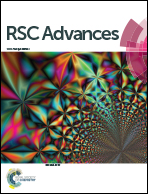A highly sensitive, selective and renewable carbon paste electrode based on a unique acyclic diamide ionophore for the potentiometric determination of lead ions in polluted water samples
Abstract
Due to the toxicity of lead(II) to all living organisms as it destroys the central nervous system leading to circulatory system and brain disorders, the development of effective and selective lead(II) ionophores for its detection is very important. In this work, 1,3-bis[2-(N-morpholino)acetamidophenoxy]propane (BMAPP), belonging to acyclic diamides, was applied as a highly selective lead(II) ionophore in a carbon paste ion selective electrode for the accurate and precise determination of Pb(II) ions even in the presence of other interfering ions. Factors affecting the electrode's response behavior were studied and optimized. Scanning electron microscopy (SEM), energy dispersive X-ray (EDX) and FT-IR spectroscopy were used for studying the morphology and response mechanism of the prepared sensor. The lipophilicity of the used ionophore, which contributes to the mechanical stability of the sensor, was studied using the contact angle measurement technique. The selectivity coefficients obtained by the separate solution method (SSM) and fixed interference method (FIM) confirmed the selectivity of the proposed sensor for Pb(II) ions. The proposed sensor exhibited a Nernstian slope of 29.96 ± 0.34 mV per decade over a wide linear range of 5 × 10−8 to 1 × 10−1 mol L−1 and detection limit of 3 × 10−8 mol L−1 for 2 months with a fast response time (<10 s) and working pH range (2.5–5.5). To further ensure the practical applicability of the sensor, it was successfully applied for the lead(II) ion determination in different water samples and the obtained data showed an agreement with those obtained by atomic absorption spectroscopy. In addition, it was successfully applied for the potentiometric titration of Pb(II) against K2CrO4 and Na2SO4.

- This article is part of the themed collection: Renewable materials and recycling


 Please wait while we load your content...
Please wait while we load your content...